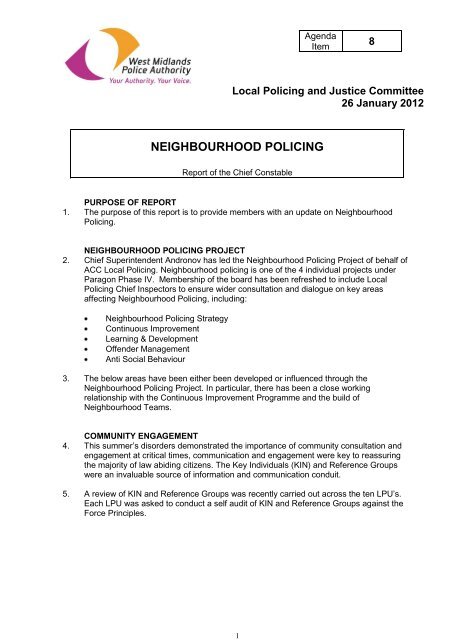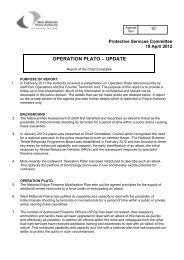NEIGHBOURHOOD POLICING - West Midlands Police and Crime ...
NEIGHBOURHOOD POLICING - West Midlands Police and Crime ...
NEIGHBOURHOOD POLICING - West Midlands Police and Crime ...
Create successful ePaper yourself
Turn your PDF publications into a flip-book with our unique Google optimized e-Paper software.
1AgendaItem8Local Policing <strong>and</strong> Justice Committee26 January 2012<strong>NEIGHBOURHOOD</strong> <strong>POLICING</strong>Report of the Chief ConstablePURPOSE OF REPORT1. The purpose of this report is to provide members with an update on NeighbourhoodPolicing.<strong>NEIGHBOURHOOD</strong> <strong>POLICING</strong> PROJECT2. Chief Superintendent Andronov has led the Neighbourhood Policing Project of behalf ofACC Local Policing. Neighbourhood policing is one of the 4 individual projects underParagon Phase IV. Membership of the board has been refreshed to include LocalPolicing Chief Inspectors to ensure wider consultation <strong>and</strong> dialogue on key areasaffecting Neighbourhood Policing, including:Neighbourhood Policing StrategyContinuous ImprovementLearning & DevelopmentOffender ManagementAnti Social Behaviour3. The below areas have been either been developed or influenced through theNeighbourhood Policing Project. In particular, there has been a close workingrelationship with the Continuous Improvement Programme <strong>and</strong> the build ofNeighbourhood Teams.COMMUNITY ENGAGEMENT4. This summer‟s disorders demonstrated the importance of community consultation <strong>and</strong>engagement at critical times, communication <strong>and</strong> engagement were key to reassuringthe majority of law abiding citizens. The Key Individuals (KIN) <strong>and</strong> Reference Groupswere an invaluable source of information <strong>and</strong> communication conduit.5. A review of KIN <strong>and</strong> Reference Groups was recently carried out across the ten LPU‟s.Each LPU was asked to conduct a self audit of KIN <strong>and</strong> Reference Groups against theForce Principles.
2Reference Groups6. Reference Groups exist at various levels across the Force; some are at early stages ofdevelopment <strong>and</strong> underst<strong>and</strong>ing their purpose, whilst others are thoroughly incorporated intodaily business practice. (e.g. BE LPU groups operating to tackle inter community violence<strong>and</strong> the presence of extremist preachers).7. The numbers of groups on each LPU vary, for example; three constituency aligned groupswithin one LPU, with another reporting attendance at 50 statutory <strong>and</strong> non statutory groups.The consistent theme in terms of “type” of group is Faith based other types vary. In relation tohow representative the groups are within the LPU‟s, this is described overall as being self led,large community groups.8. The key theme across LPUs, is that Reference Groups are used for delivery of keymessages intended for further dissemination to communities <strong>and</strong> in particular to headsof faith.9. Reference Groups are reported to be used at a combination of Ward, Constituency <strong>and</strong>LPU Levels. Two examples of terms of reference are:• Memor<strong>and</strong>um of Underst<strong>and</strong>ing for the role of a member of the reference groupincluding responsibility around disclosure of information <strong>and</strong> confidentiality which eachmember is asked to sign up to. (BS)• IAG constitution setting out what the group will / will not do as a critical friend tothe police. (SH)Key Individual Network (KIN)10. The creation of the Force KIN Principles aimed to simplify the governance <strong>and</strong> maintenanceof KIN placing emphasis on the importance of the relationship (between the police <strong>and</strong>KIN). To complement the KIN Principles a redesign of the KIN database is currentlyunderway <strong>and</strong> will form part of the Corvus Neighbourhood Profiles.11. KIN are members of the public who are willing to engage in active citizenship, they should beconsidered as „critical friends‟ <strong>and</strong> potential advocates for the Force. KIN must have trust intheir relationship with <strong>West</strong> <strong>Midl<strong>and</strong>s</strong> <strong>Police</strong> <strong>and</strong> be confident in our integrity; they must feelwilling <strong>and</strong> able to share community feelings with us. At times KIN may be critical of ourwork, this is part of their role <strong>and</strong> should be valued <strong>and</strong> respected.12. KIN are a Force commodity <strong>and</strong> therefore the relationship that develops must be professional<strong>and</strong> personable. Consideration must always be given to „consultation fatigue‟ consultationmust be fair <strong>and</strong> proportionate <strong>and</strong> should complement the ongoing relationship with theindividual concerned.13. Neighbourhood/Constituency Inspectors should own <strong>and</strong> preserve the integrity of theirrespective KIN database. Utilise community mapping to determine gaps around skills <strong>and</strong>knowledge within the KIN database <strong>and</strong> identify actions to close those gaps throughengagement.14. There is evidence that Key Individuals within communities are actively engaged with <strong>Police</strong>at a local level in a manner consistent with the Forces KIN Principles. However, the methodsof recording such relationships is inconsistent, this may be due to a reluctance to record KINon Corvus.15. The definition of „KIN‟ has been stretched by some LPUs <strong>and</strong> has culminated in a blurring oftitles such as „critical friend‟, „community contact‟, „street champion‟, <strong>and</strong> neighbourhoodwatch member across many LPU‟s. The Force accepts local flavour in defining communitycontacts in line with the guiding principles. Ethnicity is the most consistently representeddemographic group overall. Underrepresented groups highlighted by LPU‟s within the reviewwere young people, business community, Travelers, asylum seekers <strong>and</strong> disability groups.
3COMMUNITY PRIORITY SETTING16. Community engagement <strong>and</strong> problem solving will remain at the heart of neighbourhoodactivity <strong>and</strong> is defined by the Continuous Improvement process to enable the NHTs tounderst<strong>and</strong> <strong>and</strong> meet the needs of the community by encouraging better planning,providing more targeted action <strong>and</strong> improving feedback to the community. The keyaspects to this are:Step 1: Engage17. WMP‟s neighbourhood policing model is based on the „bottom-up‟ principle that prioritiesshould be identified, scoped <strong>and</strong> agreed locally with the community. Therefore, the firststep in the process is to engage at a local level, gathering relevant issues <strong>and</strong> prioritiesfrom the local area, partner agencies <strong>and</strong> professional knowledge. This builds upon <strong>and</strong>formalises existing processes <strong>and</strong> the core aspects are summarised below. Moredetailed information about the tools, methods <strong>and</strong> options are available to Officers in theContinuous Improvement Creative Engagement Toolkit.Step 2: Establish the issues <strong>and</strong> set the priorities18. Visible neighbourhood policing alone will not deliver safe <strong>and</strong> satisfied communities.Instead, the key is to recognise <strong>and</strong> underst<strong>and</strong> that different communities requiredifferent forms of access <strong>and</strong> engagement from our Neighbourhood Teams.19. This is done by establishing the neighbourhood issues <strong>and</strong> setting priorities that needadditional internal or partner support to manage effectively.i) Underst<strong>and</strong>ing local concernsNeighbourhood officers should engage with the community to underst<strong>and</strong> localconcerns – this can be done in conjunction with partners.ii)iii)Establish the issuesAn issue is anything which can be managed locally as part of daily business, whichmay or may not require partner assistance. Issues requiring longer-term resolution(including CAPT support), should be escalated to the priority setting process.Set the prioritiesUsing the priority setting process, Neighbourhood officers can obtain widersupport. Each priority must have a SARA problem-solving plan <strong>and</strong> be recordedon CORVUS.Step 3: Plan20. Planning is central to the revised neighbourhood approach, ensuring robustmanagement <strong>and</strong> a means to measure progress against the agreed community priorities(<strong>and</strong> any issues deemed sufficiently important by the Neighbourhood Inspector). It alsoprovides the basis for community feedback <strong>and</strong> for ensuring resources are beingdeployed effectively <strong>and</strong> appropriately.Steps 4 <strong>and</strong> 5: Action <strong>and</strong> Evaluate21. Once a problem solving plan has been completed, NHT should ensure that actions <strong>and</strong>progress are monitored <strong>and</strong> completed operations evaluated appropriately. This willensure that the NHT resources are being used to best effect <strong>and</strong> will also help to informthe final step in underst<strong>and</strong>ing the community – resolution <strong>and</strong> feedback. Moreover, theforce will ultimately be held to account by the public for progress against problem solvingplans <strong>and</strong>, therefore, must provide a quality of service which enhances trust <strong>and</strong>confidence.Step 6: Resolve <strong>and</strong> feedback22. Feedback to the community is the final step in the revised approach. This is afundamental part of our strategy to keep the community informed of the actions beingtaken <strong>and</strong> ensuring that they remain confident their problems are being addressed. Allproblem solving plans must include feedback actions. A community priority will not beclosed until all actions have been undertaken <strong>and</strong> completed, including communityfeedback.
5• Ensure Harm Reduction for local communitiesNEXT STEPS28. A review of Next Steps was undertaken by the Local Policing Department, this involved:• A review of Serious Acquisitive <strong>Crime</strong> <strong>and</strong> ASB performance: relating to Next Stepsareas (by using OSD measurements).• Assessment of problem solving, community engagement <strong>and</strong> capacity building withinnext steps areas.• Survey of Next Steps residents.29. The Force Organisation <strong>and</strong> Service Development Department conducted a review of theperformance of each Next Steps area across the Force. A summary of the performanceheadlines:30. Serious Acquisitive <strong>Crime</strong> (SAC)• SAC showed reductions - the volume of SAC in the NS areas was 13.7% lower (BetweenOct 2010 <strong>and</strong> May 2011) than the same period the year before; this is better performancethan total Force SAC which increased over the same period.• SAC was extremely low during the performance year 2009/10; therefore reductionsagainst this time frame will always have been difficult.• SAC in the Next Steps areas accounted for just over 3% of total SAC for the Force(previous twelve months).• SAC in the NS areas saw a reducing trend from October 2010 but this was in line with asimilar reducing trend in Total Force SAC.• NS areas on BN saw the biggest percentage reduction of -47.7% (31 fewer victims) tolast year.31. Anti Social Behaviour• Daily levels of ASB in the Next Steps areas followed a similar pattern to Total Force ASB.• In the NS areas overall the Force saw a reduction of -62.5% or -2,536 fewer incidentscompared to 2009 -2010.• All LPU‟s have seen a reduction in ASB incidents when compared to last year.• Birmingham East saw the biggest percentage reduction of 79.3%, seeing a fewer 452offences (October 2010 – May 2011).32. The Force Local Policing Department conducted an assessment of LPU activity on next Stepsareas, the findings included:33. Every LPU has identified Next Steps areas <strong>and</strong> has implemented an action plan. There issome inconsistency as to the approach with some LPUs with extremely active Next Stepsareas, subject to effective practice initiatives, with the NS areas being treated as a priority forlong term engagement <strong>and</strong> capacity building. Next Steps is considered part of business asusual on most LPUs.34. The following are a summary of the key stages of Next Steps <strong>and</strong> how they have beenimplemented across the Force:35. Local InsightSome LPUs benefitted from taking swift action in response to the surveys, demonstrating tothe public a willingness to act upon their concerns, aiming to meet expectations swiftly.36. Problem ProfilesBest practice from LPUs ensured that problem profiles were created through involvement ofNeighbourhood staff, crucially, Constituency Inspectors <strong>and</strong> Neighbourhood Sergeants. OneLPU took the analysts responsible for creating the problem profiles to the Next Steps area‟s toprovide them with the widest possible underst<strong>and</strong>ing of the challenges faced.
746. The Continuous Improvement process has introduced a shift pattern which is based upon a3,3,3 pattern but allows a small degree of flex to accommodate local needs, for example,night time economies. The basic shift pattern allows for dedicated neighbourhood teams,CAPT <strong>and</strong> investigative teams aligned to create relationships <strong>and</strong> promote consistency ofsupervision. Coverage for dedicated team rest days is managed by buddying dedicated teams whoprovide support <strong>and</strong> communication in line with the needs of the neighbourhood.PCSOs47. The review has identified visibility <strong>and</strong> reassurance as a default activity for PCSOs, the impactof that activity cannot (at this current time) be quantified. In depth problem solving by PCSOsis inconsistent, training <strong>and</strong> a greater case load in this area of business would increaseproductivity <strong>and</strong> raise the profile of PCSOs in the Community.48. The work being conducted through Continuous Improvement <strong>and</strong> the opportunity to allocateresources against dem<strong>and</strong> <strong>and</strong> need through the use of the Social Harms Index (beingdeveloped by the Local Policing Department) provides a platform for more efficient allocationof PCSOs to neighbourhoods <strong>and</strong> wards. Efficient resource allocation of Community SupportOfficers combined with targeted visibility at times <strong>and</strong> locations with greatest impact couldprovide an opportunity to create PCSO capacity. Training in problem solving <strong>and</strong> an increasedcase load will improve productivity.49 Learning <strong>and</strong> DevelopmentTraining for Supervisors, emphasising the powers <strong>and</strong> problem solving potential whichPCSOs possess.Tutoring of PCSOs as a follow on to class room learning, for example: to embed therecent statement <strong>and</strong> crime recording training.Problem solving <strong>and</strong> SARA training for all PCSOs, greater involvement in problemsolving will free warranted officer time.Scene preservation/management training for PCSOs.Contact Centre staff training in powers <strong>and</strong> role of PCSOs50. Career DevelopmentGreater emphasis on the role of tutor PCSOs, providing appropriate tutoring to assist theembedding of training <strong>and</strong> learning outside of the L&D environment).51. Impact of PCSO activityFuture OSD survey to assess the impact of PCSOs within communities.PARTNERSHIP52. ACC Local Policing appointed Chief Superintendent Kevin Bullas to review the Forceposition on partnership working in light of Government changes, new public sectorarrangements <strong>and</strong> the impact of the Governments austerity measures. The terms ofreference for this work were:To assess the impact on partnerships arising from the savings being made to the publicsector.To establish an operating model for <strong>West</strong> <strong>Midl<strong>and</strong>s</strong> <strong>Police</strong> (WMP) in relation to the waypartnerships will be carried out in the new public sector environment.To identify the training needs for staff involved in partnership working.To allow for local influences over how partnerships will be conducted in each Local AuthorityArea.To identify ways, including IT systems, to share data to allow shared underst<strong>and</strong>ingof priorities, shared vision <strong>and</strong> shared values.To ensure the principles of the Hallmarks of Effective Partnerships are adopted in theWMP operating model.To ensure the principles contained within the „Tackling <strong>Crime</strong> Together‟ document areincluded in the WMP partnerships operating model.
9LEGAL IMPLICATIONS62. The <strong>Police</strong> Authority has a general statutory duty to maintain the efficient <strong>and</strong> effective working ofthe police force for its area under Section 6 of the <strong>Police</strong> Act 1996. The Chief Constable has thedirection <strong>and</strong> control of the officers within the Force under Section 10 subject to having regard to theplanning directions set by the Home Secretary <strong>and</strong> more particularly the <strong>Police</strong> Authority under theAct. These statutory responsibilities are assisted by the policing arrangements <strong>and</strong> proposalsoutlined in this report.EQUALITIES IMPLICATIONS63. It is not believed that the project or this report has an adverse effect on any of the nine corediversity groups. An EQIA has been requested around the Continuous Improvement project <strong>and</strong>its implications for local policing delivery from the Local Policing Department.RECOMMENDATION64. That the committee notes the report.Chris SimsChief ConstableCONTACT OFFICERName: Sharon RoweTitle: Assistant Chief Constable (Local Policing)Tel: 0345 113 5000 ext 7800 6601Email: sharon.rowe@west-midl<strong>and</strong>s.pnn.police.ukBACKGROUND DOCUMENTS
















